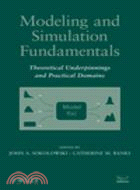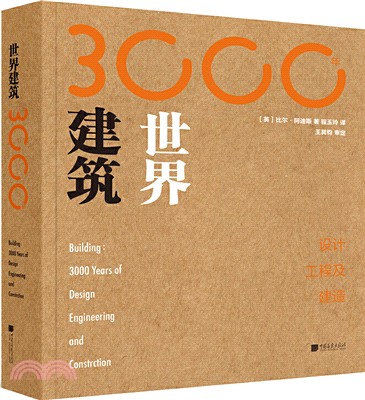Modeling And Simulation Fundamentals: Theoretical Underpinnings And Practical Domains
商品資訊
ISBN13:9780470486740
出版社:John Wiley & Sons Inc
作者:Sokolowski
出版日:2010/03/26
裝訂/頁數:精裝/454頁
定價
:NT$ 7497 元優惠價
:90 折 6747 元
若需訂購本書,請電洽客服 02-25006600[分機130、131]。
商品簡介
作者簡介
名人/編輯推薦
目次
商品簡介
An insightful presentation of the key concepts, paradigms, and applications of modeling and simulation
Modeling and simulation has become an integral part of research and development across many fields of study, having evolved from a tool to a discipline in less than two decades. Modeling and Simulation Fundamentals offers a comprehensive and authoritative treatment of the topic and includes definitions, paradigms, and applications to equip readers with the skills needed to work successfully as developers and users of modeling and simulation.
Featuring contributions written by leading experts in the field, the book's fluid presentation builds from topic to topic and provides the foundation and theoretical underpinnings of modeling and simulation. First, an introduction to the topic is presented, including related terminology, examples of model development, and various domains of modeling and simulation. Subsequent chapters develop the necessary mathematical background needed to understand modeling and simulation topics, model types, and the importance of visualization. In addition, Monte Carlo simulation, continuous simulation, and discrete event simulation are thoroughly discussed, all of which are significant to a complete understanding of modeling and simulation. The book also features chapters that outline sophisticated methodologies, verification and validation, and the importance of interoperability. A related FTP site features color representations of the book's numerous figures.
Modeling and Simulation Fundamentals encompasses a comprehensive study of the discipline and is an excellent book for modeling and simulation courses at the upper-undergraduate and graduate levels. It is also a valuable reference for researchers and practitioners in the fields of computational statistics, engineering, and computer science who use statistical modeling techniques.
Modeling and simulation has become an integral part of research and development across many fields of study, having evolved from a tool to a discipline in less than two decades. Modeling and Simulation Fundamentals offers a comprehensive and authoritative treatment of the topic and includes definitions, paradigms, and applications to equip readers with the skills needed to work successfully as developers and users of modeling and simulation.
Featuring contributions written by leading experts in the field, the book's fluid presentation builds from topic to topic and provides the foundation and theoretical underpinnings of modeling and simulation. First, an introduction to the topic is presented, including related terminology, examples of model development, and various domains of modeling and simulation. Subsequent chapters develop the necessary mathematical background needed to understand modeling and simulation topics, model types, and the importance of visualization. In addition, Monte Carlo simulation, continuous simulation, and discrete event simulation are thoroughly discussed, all of which are significant to a complete understanding of modeling and simulation. The book also features chapters that outline sophisticated methodologies, verification and validation, and the importance of interoperability. A related FTP site features color representations of the book's numerous figures.
Modeling and Simulation Fundamentals encompasses a comprehensive study of the discipline and is an excellent book for modeling and simulation courses at the upper-undergraduate and graduate levels. It is also a valuable reference for researchers and practitioners in the fields of computational statistics, engineering, and computer science who use statistical modeling techniques.
作者簡介
JOHN A. SOKOLOWSKI, PhD, is Research Professor and Director of Research at the Virginia Modeling, Analysis and Simulation Center at Old Dominion University. He is the coeditor of Principles of Modeling and Simulation: A Multidisciplinary Approach and coauthor of Modeling and Simulation for Analyzing Global Events, both published by Wiley. Dr. Sokolowski currently focuses his research on computational modeling of human and social behavior.
CATHERINE M. BANKS, PhD, is Research Assistant Professor at the Virginia Modeling, Analysis and Simulation Center at Old Dominion University. She is the coeditor of Principles of Modeling and Simulation: A Multidisciplinary Approach and coauthor of Modeling and Simulation for Analyzing Global Events, both published by Wiley. Dr. Banks's current research interests include modeling states and their varied histories of revolution and insurgency, political economy and state volatility, and theoretical modeling concepts.
CATHERINE M. BANKS, PhD, is Research Assistant Professor at the Virginia Modeling, Analysis and Simulation Center at Old Dominion University. She is the coeditor of Principles of Modeling and Simulation: A Multidisciplinary Approach and coauthor of Modeling and Simulation for Analyzing Global Events, both published by Wiley. Dr. Banks's current research interests include modeling states and their varied histories of revolution and insurgency, political economy and state volatility, and theoretical modeling concepts.
名人/編輯推薦
"This text provides a well-designed overview of M&S as a discipline useful for graduate students with engineering, mathematics or computer science background and for specialists interested in fundamental principles of M&S, its further development and applications." (Zentralblatt MATH, 2010)
目次
Preface.
Contributors.
1 Introduction to Modeling and Simulation (Catherine M. Banks).
M&S.
M&S Characteristics and Descriptors.
M&S Categories.
Conclusion.
References.
2 Statistical Concepts for Discrete Event Simulation (Roland R. Mielke).
Probability.
Simulation Basics.
Input Data Modeling.
Output Data Analysis.
Conclusion.
References.
3 Discrete-Event Simulation (Rafael Diaz and Joshua G. Behr).
Queuing System Model Components.
Simulation Methodology.
DES Example.
Hand Simulation—Spreadsheet Implementation.
Arena Simulation.
Conclusion.
References.
4 Modeling Continuous Systems (Wesley N. Colley).
System Class.
Modeling and Simulation (M&S) Strategy.
Modeling Approach.
Model Examples.
Simulating Continuous Systems.
Simulation Implementation.
Conclusion.
References.
5 Monte Carlo Simulation (John A. Sokolowski).
The Monte Carlo Method.
Sensitivity Analysis.
Conclusion.
References.
6 Systems Modeling: Analysis and Operations Research (Frederic D. McKenziei).
System Model Types.
Modeling Methodologies and Tools.
Analysis of Modeling and Simulation (M&S).
OR Methods.
Conclusion.
References.
Further Readings.
7 Visualization (Yuzhong Shen).
Computer Graphics Fundamentals.
Visualization Software and Tools.
Case Studies.
Conclusion.
References.
8 M&S Methodologies: A Systems Approach to the Social Sciences (Barry G. Silverman, Gnana K. Bharathy, Benjamin Nye, G. Jiyun Kim, Mark Roddy, and Mjumbe Poe).
Simulating State and Substate Actors with CountrySim: Synthesizing Theories Across the Social Sciences.
The CountrySim Application and Sociocultural Game Results.
Conclusions and the Way Forward.
References.
9 Modeling Human Behavior (Yiannis Papelis and Poornima Madhavan).
Behavioral Modeling at the Physical Level.
Behavioral Modeling at the Tactical and Strategic Level.
Techniques for Human Behavior Modeling.
Human Factors.
Human–Computer Interaction.
Conclusion.
References.
10 Verifi cation, Validation, and Accreditation (Mikel D. Petty).
Motivation.
Background Defi nitions.
VV&A Defi nitions.
V&V as Comparisons.
Performing VV&A.
V&V Methods.
VV&A Case Studies.
Conclusion.
Acknowledgments.
References.
11 An Introduction to Distributed Simulation (Gabriel A. Wainer and Khaldoon Al-Zoubi).
Trends and Challenges of Distributed Simulation.
A Brief History of Distributed Simulation.
Synchronization Algorithms for Parallel and Distributed Simulation.
Distributed Simulation Middleware.
Conclusion.
References.
12 Interoperability and Composability (Andreas Tolk).
Defining Interoperability and Composability.
Current Interoperability Standard Solutions.
Engineering Methods Supporting Interoperation and Composition.
Conclusion.
References.
Further Readings.
Index.
Contributors.
1 Introduction to Modeling and Simulation (Catherine M. Banks).
M&S.
M&S Characteristics and Descriptors.
M&S Categories.
Conclusion.
References.
2 Statistical Concepts for Discrete Event Simulation (Roland R. Mielke).
Probability.
Simulation Basics.
Input Data Modeling.
Output Data Analysis.
Conclusion.
References.
3 Discrete-Event Simulation (Rafael Diaz and Joshua G. Behr).
Queuing System Model Components.
Simulation Methodology.
DES Example.
Hand Simulation—Spreadsheet Implementation.
Arena Simulation.
Conclusion.
References.
4 Modeling Continuous Systems (Wesley N. Colley).
System Class.
Modeling and Simulation (M&S) Strategy.
Modeling Approach.
Model Examples.
Simulating Continuous Systems.
Simulation Implementation.
Conclusion.
References.
5 Monte Carlo Simulation (John A. Sokolowski).
The Monte Carlo Method.
Sensitivity Analysis.
Conclusion.
References.
6 Systems Modeling: Analysis and Operations Research (Frederic D. McKenziei).
System Model Types.
Modeling Methodologies and Tools.
Analysis of Modeling and Simulation (M&S).
OR Methods.
Conclusion.
References.
Further Readings.
7 Visualization (Yuzhong Shen).
Computer Graphics Fundamentals.
Visualization Software and Tools.
Case Studies.
Conclusion.
References.
8 M&S Methodologies: A Systems Approach to the Social Sciences (Barry G. Silverman, Gnana K. Bharathy, Benjamin Nye, G. Jiyun Kim, Mark Roddy, and Mjumbe Poe).
Simulating State and Substate Actors with CountrySim: Synthesizing Theories Across the Social Sciences.
The CountrySim Application and Sociocultural Game Results.
Conclusions and the Way Forward.
References.
9 Modeling Human Behavior (Yiannis Papelis and Poornima Madhavan).
Behavioral Modeling at the Physical Level.
Behavioral Modeling at the Tactical and Strategic Level.
Techniques for Human Behavior Modeling.
Human Factors.
Human–Computer Interaction.
Conclusion.
References.
10 Verifi cation, Validation, and Accreditation (Mikel D. Petty).
Motivation.
Background Defi nitions.
VV&A Defi nitions.
V&V as Comparisons.
Performing VV&A.
V&V Methods.
VV&A Case Studies.
Conclusion.
Acknowledgments.
References.
11 An Introduction to Distributed Simulation (Gabriel A. Wainer and Khaldoon Al-Zoubi).
Trends and Challenges of Distributed Simulation.
A Brief History of Distributed Simulation.
Synchronization Algorithms for Parallel and Distributed Simulation.
Distributed Simulation Middleware.
Conclusion.
References.
12 Interoperability and Composability (Andreas Tolk).
Defining Interoperability and Composability.
Current Interoperability Standard Solutions.
Engineering Methods Supporting Interoperation and Composition.
Conclusion.
References.
Further Readings.
Index.
主題書展
更多
主題書展
更多書展今日66折
您曾經瀏覽過的商品
購物須知
外文書商品之書封,為出版社提供之樣本。實際出貨商品,以出版社所提供之現有版本為主。部份書籍,因出版社供應狀況特殊,匯率將依實際狀況做調整。
無庫存之商品,在您完成訂單程序之後,將以空運的方式為你下單調貨。為了縮短等待的時間,建議您將外文書與其他商品分開下單,以獲得最快的取貨速度,平均調貨時間為1~2個月。
為了保護您的權益,「三民網路書店」提供會員七日商品鑑賞期(收到商品為起始日)。
若要辦理退貨,請在商品鑑賞期內寄回,且商品必須是全新狀態與完整包裝(商品、附件、發票、隨貨贈品等)否則恕不接受退貨。



























